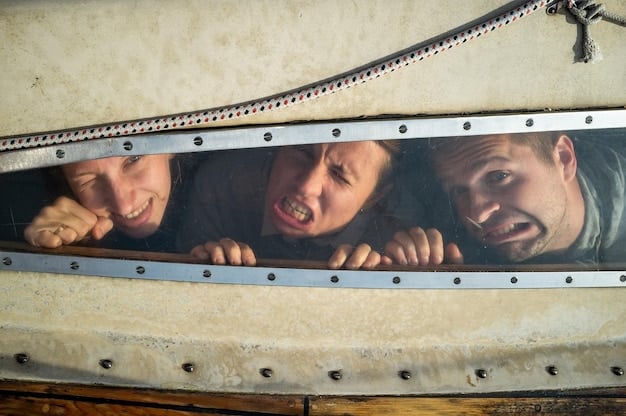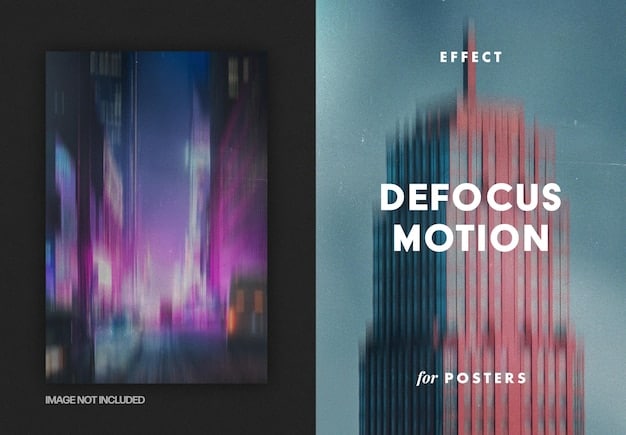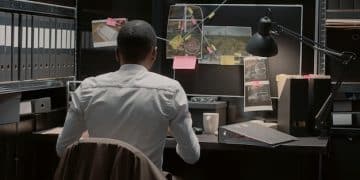The Director’s Cut Dilemma: Are Extended Versions Really Better?

The Director’s Cut Dilemma: Are Extended Versions of Movies Really Better? A 2025 Analysis explores whether director’s cuts and extended versions enhance a film, providing additional context, character development, or action, or if they dilute the original artistic vision and pacing, weighing both artistic and commercial aspects.
Have you ever wondered if those extended versions of your favorite movies are truly superior? The Director’s Cut Dilemma: Are Extended Versions of Movies Really Better? A 2025 Analysis aims to dissect this cinematic quandary, exploring the artistic and commercial motivations behind these releases.
The Allure of the Director’s Cut
The director’s cut holds a certain mystique, promising a deeper, more complete vision of a film. But what exactly constitutes a director’s cut, and how does it differ from the theatrical release?
Often, a director’s cut represents the filmmaker’s original intent, free from studio interference or marketing constraints. This can result in restored scenes, altered pacing, or even entirely new storylines.
Defining the Director’s Cut
A director’s cut isn’t simply a longer version of a movie. It’s often a re-edited and re-imagined version, reflecting the director’s true artistic vision.
The Appeal to Filmmakers
For directors, these cuts offer a chance to reclaim their work and present it as they originally intended, without compromising artistic integrity.
- Restoration of scenes: Important plot elements or nuance can be re-integrated back into the film.
- Altered pacing: Directors can adjust the rhythm of a film to control the emotional and narrative flow.
- Complete story arcs: Subplots or character arcs that got shortened in theatrical releases can get their proper conclusion.
Ultimately, the allure of the director’s cut resides in the promise of a purer, more authentic cinematic experience, aligned with the director’s original vision.
Artistic Vision vs. Commercial Constraints
The tension between artistic vision and commercial viability often dictates the fate of a film. The theatrical release is usually a compromise. Director’s cuts are often free from those concerns.
Studios are primarily concerned with box office success and audience appeal. This can lead to cuts that prioritize pacing, action, or star power over narrative depth or character development.
The Studio Influence
Studios often prioritize mass appeal, sometimes at the expense of the director’s vision. This can lead to significant alterations to the original cut.
When Artistic Integrity Takes a Backseat
Market research, test screenings, and executive mandates can all influence the final theatrical cut, potentially diluting the director’s original vision.

The director’s cut can then be seen as an opportunity to restore that integrity, presenting the film as the director originally intended.
In summary, the battle of artistic vision versus commercial interests plays a crucial role in defining whether a theatrical cut or a director’s cut becomes the definitive version.
Pacing and Narrative Flow
One of the most significant differences between theatrical releases and director’s cuts is often the pacing and narrative flow of the film. Extensions to runtime play a crucial impact. Slower cuts don’t always equate to bad movies.
Theatrical releases often prioritize a fast-paced, action-packed experience designed to keep audiences engaged. Director’s cuts, however, may opt for a more deliberate pace, allowing for deeper character development and thematic exploration.
The Impact of Extended Scenes
Extended scenes can provide crucial context, deepen character relationships, and enhance the overall narrative impact, but they can also slow down the pace.
Finding the Right Rhythm
The ideal pacing depends on the individual film and the director’s intent. A slower pace isn’t necessarily a detriment; it can enhance the film’s emotional resonance.
Extended versions are an opporunity to add to already compelling stories. It is up to the director, or the studio, to make that call.
- Contextual Depth: Extended scenes are a chance to provide information regarding motivations.
- Character Development: Nuance is key to getting audiences invested in characters.
- Better Narrative: Extra character and context can result in a better story, overall.
Ultimately, the success of either approach depends on how well it serves the story and enhances the viewing experience.
The Audience Perspective: More or Less?
Ultimately, the question of whether director’s cuts are “better” comes down to individual preference. Some viewers appreciate the added depth and detail, while others may find the extended runtime tedious.
Some viewers believe that director’s cuts provide a richer, more rewarding experience. They appreciate the opportunity to delve deeper into the story and characters.
Appreciating the Extended Experience
Fans often celebrate longer versions of their favourite films, as it gives them more of what they love, an extension of the original viewing experience.
Criticisms of Director’s Cuts
Conversely, others find extended versions to be self-indulgent. They may feel that the added scenes are unnecessary. The added fat and fluff is not always welcome.
Personal preference comes into play, but there are very concrete pro’s and con’s associated with it.
Are you a fan of slower burn films, or do you need action to have a compelling story?
The reaction of the audience to a director’s cut is highly subjective and depends heavily on individual taste and expectations. Some embrace the thorough version, while others would prefer a more condensed, streamlined narrative.
Notable Examples: Successes and Failures
Examining specific director’s cuts can provide valuable insights into the potential benefits and pitfalls of extended versions. Some director’s cuts are widely considered superior to the theatrical release, while others are viewed as unnecessary or even detrimental.
*Blade Runner: The Final Cut* is often cited as a definitive example of a director’s cut that enhances the original film. It offers a clearer vision of the the protagonist’s identity, and improved pacing.
Success Stories in Director’s Cuts
*Kingdom Of Heaven (Director’s Cut)* is a good example of context and character driving the film. It is viewed as superior to it’s theatrical release.

When Extended Isn’t Always Better
However, not all director’s cuts are successful. Some films suffer from bloated runtimes or unnecessary additions that detract from the overall experience.
- Blade Runner The Final Cut: A great example of a director’s cut being lauded as better.
- Kingdom Of Heaven (Director’s Cut): The extra character and context make for a superior film, overall compared to its original cut.
- The Abyss (Special Edition): Extra content adds more context and nuance to the story, leading it to be well-recieved.
Ultimately, the success of a director’s cut depends on the specific film and the execution of the extended version. It’s not a guarantee of improvement.
The Future of Director’s Cuts: A 2025 Perspective
As technology advances and audience expectations evolve, the future of director’s cuts remains uncertain. Streaming services and digital distribution platforms offer new possibilities for filmmakers to present their extended visions, but they also raise new challenges.
Streaming services like Netflix and Amazon Prime Video have become increasingly interested in offering director’s cuts as a value-added feature. This allows audiences to experience films in their entirety, without the constraints of traditional theatrical distribution.
The Rise of Streaming Director’s Cuts
With home entertainment options as good as they are, the ability to have longer, more intimate cuts of our favourite stories helps solidify these platforms.
The Challenge of Discovery and Marketing
However, the sheer volume of content available on these platforms can make it difficult for director’s cuts to stand out. Effective marketing and discoverability are crucial for ensuring that audiences are aware of their existence.
The future may see a blend of theatrical releases and director’s cuts available simultaneously, catering to different audience preferences. Some viewers may opt for the streamlined theatrical experience, while others may seek out the more immersive director’s cut.
| Key Point | Brief Description |
|---|---|
| 🎬 Artistic Vision | Director’s cuts reflect the director’s original intent, free from studio constraints. |
| ⏱️ Pacing and Flow | Extended scenes can provide more context and deeper character development |
| 👍 Audience Reception | Appreciation varies; some value added depth, others find extended runtimes tedious. |
| 🌐 Streaming Era | Streaming platforms offer space for director’s cuts, but visibility remains a challenge. |
[FAQ]
▼
A director’s cut is a version of a film that reflects the director’s original vision, often differing from the theatrical release due to studio interference or market demands. Edits can include cuts, additions, or pacing alterations.
▼
Not necessarily. While some director’s cuts are considered superior due to restored scenes or improved pacing, others may be deemed unnecessary or even detrimental to the overall viewing experience, according to personal preference.
▼
Studios prioritize box office success. They change pacing, shorten run times, and focus on particular actors. These all impact the feel and ultimate vision of the film by the director.
▼
Streaming have created new pathways for director’s cuts where these alternative versions can be distributed and made accessible to viewers at home, enabling them to view the content in full, like never before.
▼
Blade Runner: The Final Cut and *Kingdom Of Heaven (Director’s Cut)* are often cited as examples of a director’s cut at its very best. These films are superior in vision, pace and narrative.
Conclusion
The director’s cut dilemma remains a fascinating and subjective debate within the world of cinema. While extended versions offer the potential for a richer, more complete cinematic experience, they are not always guaranteed to be superior to the original theatrical release. Ultimately, the value of a director’s cut depends on individual preference, the specific film, and the skill with which the extended version is executed.





